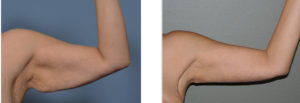Of the many bariatric surgery patients that I have seen over the years who have lost 100 or more pounds, the concern over their saggy arms is often a top concern. I would have to say that the arm concern combined with the stomach or waistline are almost always the top two priorties of the massive weight loss patient. I should add one caveat, the arms are an issue exclusively for women. I have yet to see a male patient who has put forth this concern to me. That does not mean that men don’t develop flabby arms after bariatric surgery, it just doesn’t cause the same problems that it does for women.

While they can be raised revised later, from which they turn out much better, an arm scar that parallels the vertical axis of the arm is one of the poorer scar outcomes from body contouring in the bariatric surgery patient. Then there is the scar banding (contracture) issue that can occur as the scar crosses from the arm into the axilla. (armpit) It is always necessary to bring the skin excision pattern into the armpit and often down into the side chest wall. Like all scars that cross areas of movement, a tight band often develops. Sometimes I have incorporated a Z-plasty into the skin cutout and other times, I have just waited to see whether a bothersome scar contracture develops. For most patients, the degree of improvement in the shape of their arms seems to overshadow significant concerns about an axillary scar contracture.
One of the nicest things about an arm lift procedure is that it is associated with little to no postoperatve pain and recovery from it is fairly quick. Other than some mild swelling in the hands during the first few days after surgery, most problems with arm lifts are relatively minor including snall fluid collections (seromas), spotty areas of delayed incisional healing, and the scar issues previously mentioned. For these reasons, an arm lift is a perfect compansion to other more major body contouring procedures in the bariatric surgery patient such as tummy tuck, circumferential body lift, and breast lift/implants.
Dr Barry Eppley
Indianapolis, Indiana


